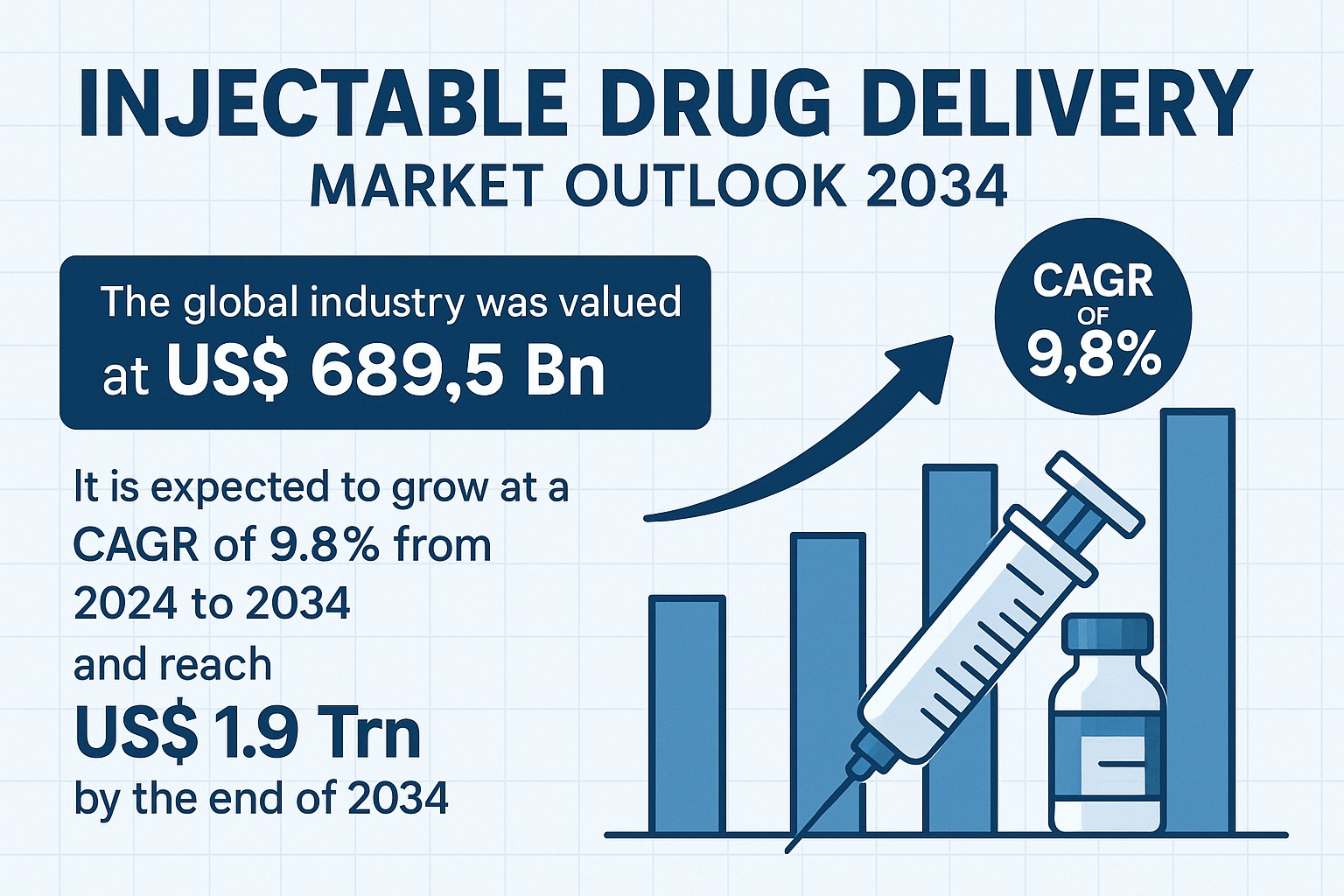Injectable Drug Delivery Market Outlook 2034: Rising Biologics Adoption, Technological Advancements, and Chronic Disease Burden to Push Market Value from USD 689.5 Billion in 2023 to USD 1.9 Trillion by 2034

The global healthcare landscape is experiencing a major transformation fueled by technological evolution, the rise of biologics, and increasing demand for self-administered therapies. The injectable drug delivery market, a critical segment that supports modern treatment modalities, is projected to record robust expansion over the next decade. Valued at US$ 689.5 billion in 2023, the market is expected to reach approximately US$ 1.9 trillion by the end of 2034, reflecting an impressive compound annual growth rate (CAGR) of 9.8% from 2024 to 2034.
This accelerating demand is supported by a global rise in chronic diseases, improved patient awareness, and product innovation in delivery systems such as auto-injectors, prefilled syringes, and needle-free injectors. As biologics and biosimilars continue to reshape therapeutic strategies for conditions such as cancer, diabetes, autoimmune disorders, and cardiovascular diseases, injectable delivery systems have become indispensable in ensuring patient compliance, precision, and treatment efficiency.
Market Dynamics and Analyst Perspective
Analysts report that the surge in biologic drug approvals, coupled with an expanding biosimilar pipeline, is dramatically enhancing the adoption of injectable systems. These therapies often require precise dosing and rapid absorption—criteria best met through injectable formats. Additionally, the healthcare sector is witnessing a strong shift toward self-administration models, especially for chronic disease management. This trend is stimulating innovation in smart injectors, digital connectivity platforms, and user-friendly designs.
The growing prevalence of chronic illnesses significantly fuels market expansion. For instance, diabetes and cancer continue to be among the most treated diseases via injectable therapies. In the U.S. alone, more than 38.4 million citizens were living with diabetes in 2021, demonstrating the scale of the long-term need for injectable medications such as insulin and GLP-1 analogs. Similarly, injectable immunotherapies and oncologic drugs are reshaping cancer treatment protocols, further strengthening market demand.
However, despite rapid growth, the industry faces challenges such as the risk of needle-stick injuries, waste generation, and user hesitation—particularly among elderly patients. Safety-engineered needles, needle-free systems, and connected injection technologies are emerging as effective solutions to overcome these barriers.
Technological Advancement Leading Market Growth
Innovation remains at the center of the injectable delivery transformation. Next-generation devices now offer enhanced accuracy, connectivity with health platforms, and increased patient autonomy. Advancements include:
- Prefilled syringes and pen injectors for convenience and reduced contamination risks
- Auto-injectors supporting self-administration for conditions like rheumatoid arthritis and multiple sclerosis
- Needle-free jet injectors and microneedle systems minimizing discomfort and reducing medical waste
- AI-driven formulation optimization, enabling faster and cost-effective development of long-acting injectable (LAI) drugs
A notable achievement in January 2023 showcased how artificial intelligence is accelerating long-acting injectable development by predicting drug release behavior—an advancement expected to significantly shorten clinical formulation cycles and reduce costs.
These innovations align with rising demand for minimally invasive, patient-centric drug delivery, making the injectable drug delivery industry a core enabler of next-generation healthcare.
Regional Outlook and Opportunities
North America held the dominant share in 2023 and is expected to maintain its leadership through 2034. Factors driving regional prominence include high healthcare expenditure, advanced pharmaceutical production capacity, and a rising volume of regulatory approvals for new injectable medicines and delivery systems.
For example, the approval of ready-to-use ephedrine sulfate injection in prefilled syringe format by the U.S. FDA demonstrates an increasing shift toward preconfigured, safe, and time-saving injectable formats in clinical settings. Europe and Asia Pacific are projected to exhibit significant growth, supported by expanding healthcare infrastructure and rising adoption of biologics and biosimilars.
Asia Pacific, in particular, is expected to become a high-value growth hub due to its large patient population, emerging pharmaceutical manufacturing capabilities, and increasing investments by global pharmaceutical giants.
Competitive Landscape and Strategic Initiatives
The injectable drug delivery market is highly competitive, with major companies actively pursuing product launches, regulatory filings, strategic partnerships, and geographic expansion to strengthen their market position. Industry leaders such as Becton, Dickinson and Company, Pfizer, Eli Lilly and Company, Baxter International, SCHOTT Pharma, and Terumo Corporation are channeling resources into R&D to enhance safety, accuracy, and patient usability.
Recent developments underscore ongoing transformation:
- Launch of PEMRYDI RTU in 2024, the first ready-to-use pemetrexed formulation
- Strategic partnership between Aptar Digital Health and SHL Medical to advance smart injectable solutions
- Approvals of needle-free insulin delivery systems, connected biosimilar pens, and prefilled autoinjector platforms
These activities indicate increasing market maturity and a shift toward integrating drug formulations with advanced delivery mechanisms.
Future Outlook
With the pharmaceutical ecosystem embracing advanced biologics, personalized medicine, and digital health integration, the injectable drug delivery market is expected to remain indispensable in the future of healthcare. The ongoing shift toward home-based treatment and chronic care therapies will continue to accelerate demand for effortless, safe, and technology-enabled injection systems.
By 2034, the market is expected to transform into a highly digitized and patient-empowered healthcare segment, where treatment efficiency, dosage personalization, sustainability, and device connectivity become standard practice.
In summary, the injectable drug delivery market is positioned for strong long-term expansion, supported by technological innovation, increasing disease burden, regulatory momentum, and accelerating demand for biologics. As the market advances toward US$ 1.9 trillion by 2034, industry stakeholders are expected to capitalize on emerging opportunities across smart injectors, long-acting formulations, biosimilars, and needle-free delivery platforms—reshaping the future of medical care delivery.
- Art
- Causes
- Crafts
- Dance
- Drinks
- Film
- Fitness
- Food
- Oyunlar
- Gardening
- Health
- Home
- Literature
- Music
- Networking
- Other
- Party
- Religion
- Shopping
- Sports
- Theater
- Wellness


